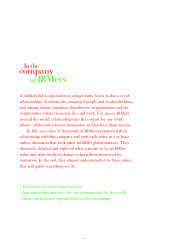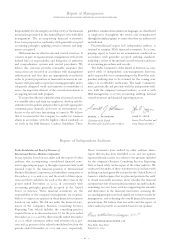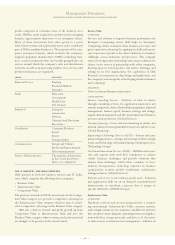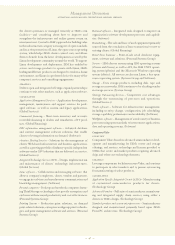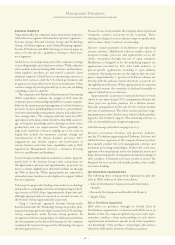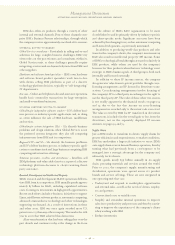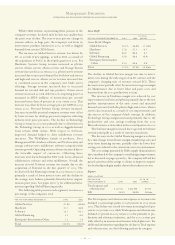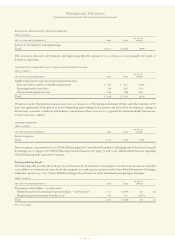IBM 2003 Annual Report Download - page 47
Download and view the complete annual report
Please find page 47 of the 2003 IBM annual report below. You can navigate through the pages in the report by either clicking on the pages listed below, or by using the keyword search tool below to find specific information within the annual report.
The company’s effective tax rate increased by almost 1 point
primarily due to a less favorable mix of geographic income
and the absence of the tax benefit associated with the
Microelectronics actions taken in the second quarter of 2002.
With regard to Total Assets, approximately $7 billion of
the increase relates to the impact of currency translation.
The remaining increase primarily consists of an increase in
Goodwill associated with recent acquisitions and increased
pension assets, as well as strong cash performance. The
increase in cash during 2003 was due to the combination of
stronger operating results and lower pension funding in
2003. The company reduced non-Global Financing debt in
2003 as a result of strong 2003 cash flows from operations.
Global Financing debt decreased, but the company’s Global
Financing debt-to-equity ratio remained flat at 6.9 to 1 and
within the company’s target range.
Looking forward, the company’s business model targets
revenue to grow in the mid to high single digits and earnings
per share to grow at low double digits over the long term.
The company’s ability to meet these objectives depends on a
number of factors, including those outlined on page 50 and
on pages 101 and 102.
Global Services signings were $55 billion in 2003 as com-
pared to $53 billion in 2002. The Global Services backlog is
$120 billion at December 31, 2003.
description of business
Please refer to IBM’s Annual Report on Form 10-Kfiled on or about
March 8, 2004, with the Securities and Exchange Commission
(SEC) for a more detailed version of this Description of Business,
especially the detailed “Significant Factors Affecting IBM’s
Business” section.
IBM focuses on the intersection of business insight and
technological innovation for enterprise clients.
Over the past decade, IBM has been a leader in the IT
market’s shift of focus from selling hardware, software and
services, to the creation of solutions to clients’ business
problems. During the early years of the Internet’s entry into
mainstream commerce, communications and business oper-
ations in the mid- to late- 1990s, value was created first
through providing widespread access and then through the
integration of business processes, such as supply chain,
client relationships and human resources. Today, IBM is once
again leading the industry toward the more fundamental,
industry-specific transformations of on demand business.
In its relationships with its clients, IBM has found that a
majority of enterprises are concerned with four main issues:
•Demand for faster innovation
•Reducing expenses
•Integration across the organization’s “value chain” (repre-
senting every transaction or interaction within an enterprise,
with other enterprises and with individuals)
•Demand for predictable return on investment
By redesigning their business processes and organizational
structure, supported by and enabled by new systems operat-
ing environments, these clients are seeking to become on
demand businesses.
IBM defines an on demand business as an enterprise
whose business processes are:
•Responsive to any client demand, market opportunity or
external threat;
•Integrated end-to-end across the company; and
•Integrated across industry value nets, interconnected chains
of partners, suppliers and clients.
An essential aspect of an on demand operating environment
is that its infrastructure is based on industry-wide standards
(commonly referred to as “open standards”). In IBM’s view,
an investment in such an infrastructure provides the greatest
returns rather than relying on proprietary control by a single
company or affiliation of companies. One positive devel-
opment in this regard is the emergence of “open source”
operating systems and programming languages that benefit
from further development by the business and IT communi-
ties, as in the case of the Linux operating system or the Java
programming language.
However, to realize the full benefits of an on demand
environment, solutions with the highest returns also require
the transformation and integration of business processes
within and among institutions.
IBM’s clients include many different kinds of enterprises,
from sole proprietorships to the world’s largest organizations,
governments and companies representing every major
industry and endeavor. Over the last decade, IBM has exited
or greatly de-emphasized its involvement in consumer markets
and divested itself of other non-core businesses to concentrate
on the enterprise market. In IBM’s view, the enterprise market
represents approximately two-thirds of the IT industry’s
revenue, as well as twice the growth and three times the
Management Discussion
INTERNATIONAL BUSINESS MACHINES CORPORATION AND SUBSIDIARY COMPANIES
45







